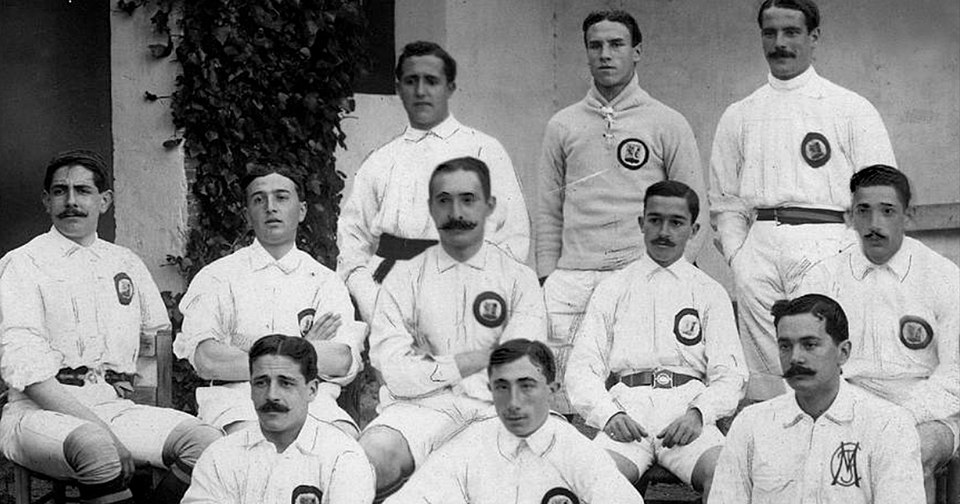Arthur Johnson from Dublin, a seminal figure in Real Madrid’s rise to the top, was remembered at his graveside in Liverpool this week
 Arthur Johnson circa 1905 (Public domain image based on historical sources — early 20th century pic)
Arthur Johnson circa 1905 (Public domain image based on historical sources — early 20th century pic)The star performers of Real Madrid: Alfredo Di Stéfano, Ferenc Puskás, Zinedine Zidane, Cristiano Ronaldo — just some of the GOAT players who have turned out for not just the most dominant team in the global game, but the most successful club in any sport.
But few would add the name of Dublin man Arthur Johnson to that list; most people won’t even be aware of him. Yet Johnson was utterly pivotal to the Spanish club’s development and rise to becoming the greatest club in the world — he was even responsible for giving the club their famous white strip.
Arthur Johnson died in 1929 and is buried in Wallasey, Liverpool. This week, Spanish, English and Irish fans joined forces to remember the Dublin player ahead of the Liverpool v Real Madrid Champions League fixture.
Supporters from both clubs laid wreaths at Johnson’s grave in Rake Lane Cemetery, Wallasey. The ceremony at his graveside, attended by members of the Peña Madridista La Gran Familia and members of Liverpool fan clubs, included prayers in Spanish and an exchange of club gifts.
Should you wish to pay your respects, he is buried in grave 177, plot 16C of Rake Lane Cemetery.
Until recently, the grave was neglected and overgrown; the inscription was barely legible. But then local historian and YouTuber Kevin Cuthbertson decided to take action, cleaned the grave up, and a plaque was erected outlining Johnson’s contribution to the game.
The Athletic, part of the New York Times group, quotes Cuthbertson as saying: “What inspired me was finding out Arthur was lying there for almost 100 years with zero recognition from anyone,” he says. “Even if I could just do something as little as cleaning his stone so it stood out a little bit better, at least it was something.”
Cuthbertson is of course correct. His contribution to Real Madrid has largely been unheralded, despite being one of the most important figures in the amateur beginnings of the club. He brought tactics and moves of a more advanced type of football that had begun to develop in England — where the sport was invented and codified in the 19th century — and introduced it to Madrid FC, which became Real Madrid. He is also credited with scoring the club’s first-ever goal — against a team that would become Real’s great rivals, Barcelona.
Johnson played as both a forward and a goalkeeper, and went on to become their manager for ten seasons. He coached Santiago Bernabéu, whoc became Real Madrid’s legendary president, and after whom their home stadium is names.
According to The New York Times, which also covered the graveside tribute for Liverpool supporters in the US, he is their second-longest-serving manager after Miguel Muñoz.
The Spanish were eager learners, in due course becoming the most successful team ever in the Champions League, formerly the European Cup.
The Athletic quotes Alfredo Relaño, a journalist for the major Spanish newspaper Marca and a sports historian. Relaño said that he grew up on stories about Johnson’s importance to the club. His father had told him about a Dublin man coming to the city and explaining all the rules to them at the beginning of the 20th century. This was the very genesis of football in Spain, a country that was to embrace the sport and become one of the world’s major footballing nations.
 Real Madrid players 1902-1908 including Arthur Johson, middle back row (pubic domain)
Real Madrid players 1902-1908 including Arthur Johson, middle back row (pubic domain)From Dublin to Madrid via England and back again
BORN in Dublin in 1878, Johnson moved to Spain in 1902 to work for an engineering firm — he helped build Madrid’s sewage system.
After retiring from football, Johnson returned to Merseyside to work with the United Alkali Company and served as secretary of his local bowls club.
After Johnson’s spell in Madrid, he may have returned to Dublin, although that is not clear. But he definitely fetched up in Liverpool, working there for some years before his death from pneumonia in 1929.
A century later, as Liverpool and Real Madrid met again at Anfield, Irish fans who attended the ceremony could take quiet pride in knowing that one of their own helped lay the foundations of one of football’s greatest dynasties. No other No Irish-born player is recorded as having appeared for Real Madrid’s first team since Johnson.
Liverpool fans also enjoyed the fact that their team triumphed 1-0: the scorer of the goal, Alexis Mac Allister, is an Argentine whose ancestry harks back to Donabate, Co. Dublin.
The origins of Real Madrid
Founded in 1902 as “Madrid Football Club”, Real Madrid was granted the “Real” (“Royal”) prefix by King Alfonso XIII in 1920.
The club has since grown into one of the most decorated and valuable sports organisations in the world.
Its early years saw regional successes in the Copa del Rey before Spanish league football gained full structure in the 1920s and 1930s.
In the 1950s and 1960s, Madrid became synonymous with European dominance — most famously winning five consecutive European Cups starting in 1956.
The club has since added a vast haul of La Liga titles, Spanish Cups, and European trophies, cementing its claim as one of the elite global football brands.
The Irish Post is indebted to the Liverpool Echo for help with this story
For more:
https://www.liverpoolecho.co.uk/news/liverpool-news/real-madrids-first-ever-goalscorer-32805355

